
Aquaculture refers to the farming of aquatic organisms, including finfish, crustaceans, mollusks, plants, and algae for human use. It has been practiced by cultures around the globe for millennia. However, as global fish stocks decline, and the negative consequences of land-based animal agriculture become increasingly obvious, aquaculture has been touted as a sustainable solution to meet the dietary needs of a growing global population. Its proponents argue that the “blue economy” will revolutionize the global food system. Indeed, the farming of aquatic animals is the fastest-growing sector in agriculture in the United States and worldwide, with global production of aquatic species tripling over the past two decades. Amid such rapid growth, the significant animal welfare and environmental ramifications of an increasingly industrialized aquaculture sector have largely been ignored.
Aquaculture in the United States and globally
According to the most recent US Department of Agriculture census, the most farmed fish by weight are, in descending order, catfish, trout, and tilapia. Other commonly produced species in the United States are bass, carp, flounder, perch, red drum, sturgeon, and Atlantic and Pacific salmon (the census does not report weight for salmonid species, however). The states producing the most fish by value are Mississippi, Alabama, Texas, Idaho, and California. Asia is the largest producer and consumer of farmed aquatic species globally. China—considered the birthplace of fish farming—is particularly noteworthy in the diversity of production methods and species it farms.
The Food and Agriculture Organization of the United Nations (FAO) reported as of 2020 that farmed finfish totaled 57.5 million tons—49.1 million from inland aquaculture and the remaining 8.3 million from marine aquaculture and on-shore coastal aquaculture. The number of individual fish this represents is unknown, but a recent study concluded that between 78 and 171 billion farmed fish were killed in 2019. The majority of these (70–72%) have no protection under national animal welfare laws, and less than 1% have fish-specific legal protection at slaughter.
Fish Sentience
The scientific consensus surrounding the sentience of fish has evolved significantly in recent decades, with the best available evidence showing that fish are considerably more cognitively and emotionally complex than previously thought. Fish have specialized nerve endings called nociceptors that respond to harmful stimuli, indicating that they can perceive and respond to pain. Studies have demonstrated behaviors that show pain avoidance, such as reduced feeding, altered swimming patterns, and avoidance of painful stimuli.
While a fish’s brain is structurally different from a mammal’s in many ways, fish have analogous structures responsible for higher cognitive functions such as spatial learning, memory, decision-making, and emotional processing. Observations of fish behavior reveal that they can experience fear, stress, and even pleasure. They display complex social behaviors and form social bonds. Studies have revealed complex cognitive abilities in various fish species, including long-term memory, learning, and problem-solving. For example, fish in the wrasse family use anvil shaped rocks to crack open bivalves; other fish can learn to navigate mazes and recognize individuals.
The World Organisation for Animal Health has established welfare codes for farmed fish in recognition of their sentience and the attendant risk of compromised welfare inherent in most modern animal farming operations. Yet, this recognition of sentience has not necessarily translated into consideration for fish on an individual level. In fact, the statistics of fish production have always been and continue to be reported in tons, rather than individuals, as farmed land animals are. Farmed fish have no legal protection under state or federal law in the United States.
Octopus farming is another significant animal welfare concern in aquaculture. Decapod crustaceans (lobsters, shrimp) are discussed below.
Welfare Implications of Fish Farming
Both raising conditions and methods of slaughter raise serious issues regarding the welfare of farmed aquatic species.
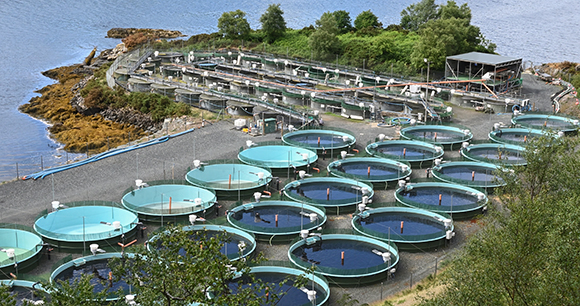
Water Quality
Unsurprisingly, water quality has a significant effect on morbidity, mortality, and welfare of fish. Health and welfare are compromised if their aquatic environment lacks an adequate amount of dissolved oxygen (allowing fish to breathe), contains excess ammonia from waste buildup, or is too acidic or too alkaline. Ideal water quality parameters vary between species.
Stocking Density
As with farmed terrestrial species, the amount of space available to each animal (stocking density) impacts welfare. High stocking densities have been shown to cause water quality deterioration, higher rates of injuries, increased inter-fish aggression, changes in behavior (e.g., reduced feed intake), and greater vulnerability to disease and parasites. In farmed salmon, for example, one of the largest welfare challenges is the control of sea lice, which proliferate in crowded net pens and feed on the fish’s living skin.
Stunning and Slaughter
Suffering and pain can be most acute at slaughter and during associated handling and transport. To ensure the least amount of suffering at slaughter, a stunning method that renders the animal immediately and painlessly unconscious (not merely immobilized) should be used before the killing cut.
Frequently employed methods of slaughtering fish, however, include conscious decapitation, evisceration or exsanguination by gill cutting; live chilling in ice slurry (leading to a slow death either by hypothermia or asphyxiation), immersion in water containing high concentrations of dissolved gas (CO2, N2, or CO), or asphyxiation via removal from water. None of the methods result in the animal being rapidly rendered insensible before death.
Although appropriate stunning methods vary between species, more well-studied methods include percussive (via a blow to the head if properly performed) and electrical stunning before cutting or decapitation. Percussive stunning, however, is subject to greater human error and can often fail. Thus, the preferred humane method is electricity, as it is more reliable and, if the voltage is high enough, can serve as the method of slaughter as well. The vast majority of fish are not stunned before slaughter, and while research has been undertaken for the development of humane slaughter methods for salmonids and trout, there is a gap in such research regarding humane slaughter of other aquatic species.
Environmental Enrichment
The most overlooked aspect of welfare in aquaculture is environmental enrichment—providing animals with sensory and motor stimulation to enhance their well-being, which also affects productivity. Enrichment allows animals to engage in biologically driven behaviors and promotes psychological wellness through physical exercise and cognitive stimulation and challenges. Enrichment can be divided into these general categories:
- Social – Allowing interactions with others of their species or with other species in a manner appropriate for the species and life stage. This could require the inclusion of material or structures for shelter/hiding and/or adequate space for schooling.
- Physical – Providing an environment that mimics the natural habitat in its complexity—for example, through shelter, plants, and substrate for nesting or burrowing.
- Sensory – Providing various visual, auditory, olfactory, and taste stimuli.
- Occupational – Providing mental and physical stimulation via the opportunity to confront challenges or puzzles, anticipate routine events, and control or manipulate their environment.
- Dietary – Providing variety in food type or delivery method.
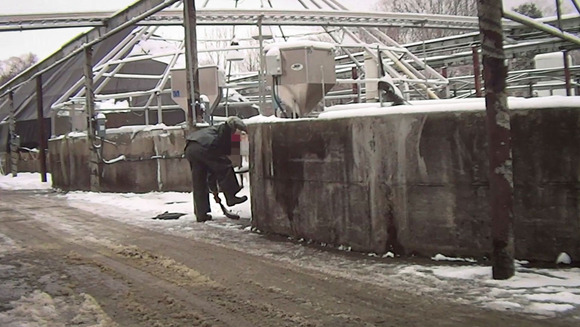

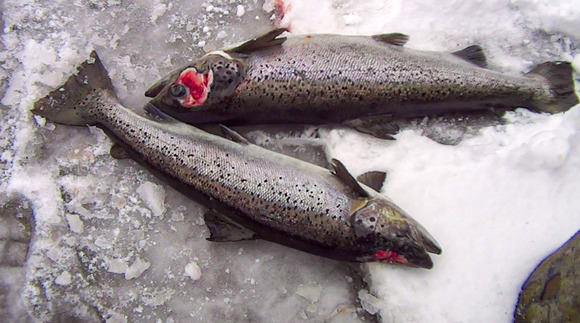

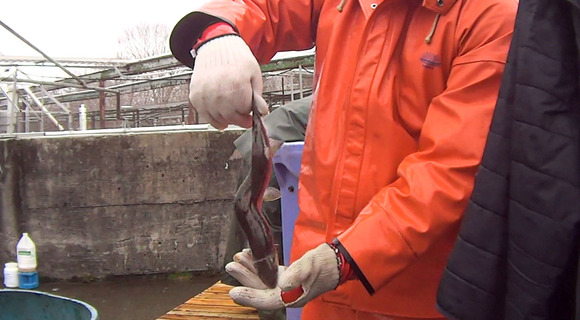
An undercover investigation of an industrial Atlantic salmon farm by Animal Outlook revealed a number of serious welfare issues. These included extreme crowding in otherwise barren tanks, high mortality, fish with genetic deformities and open sores caused by fungal infections, fish being left to suffocate in buckets, ineffective anesthetization for vaccinations and fin clipping, and workers using particularly rough handling methods such as tossing live fish, stomping on them, and slamming them into concrete.
Other Welfare Considerations
- Transport – Some aquatic species are transported between locations based on the rearing stage, but transport most often occurs when fish are sent for slaughter and processing. Welfare is impacted by the handling required for collection, loading, and unloading and by conditions during transport such as overcrowding and poor water quality.
- Lack of individual care – The welfare of farmed fish is typically assessed at the group rather than individual level. Because fish are small and can be difficult to access within aquatic environments, they are rarely evaluated or treated individually. Accordingly, sick fish are often not caught and culled or treated, meaning they can languish for extended periods of time.
- Food restriction – Although cold-blooded animals are less affected by food deprivation, fish are frequently fasted, sometimes for several weeks, before slaughter.
Methods of farming
Aquatic farming methods vary significantly across the world because it can be done in freshwater bodies, marine environments, or structures constructed on land. However, as with other forms of agriculture—where mass production of uniform products is the goal—aquaculture in all forms is becoming increasingly industrialized. Common methods are as follows:
- Open net pens – Netted-off areas located in coastal marine waters or in freshwater lakes. (Salmon are most commonly farmed in sea pens, and tilapia and catfish are often farmed in freshwater lakes.) These are open systems because they allow for the exchange of water, nutrients, and other materials between the facility and the surrounding environment. Of particular concern is the release of waste, chemicals, parasites, and diseases from these pens, as well as the release into the wild of non-native or genetically modified farmed species (discussed below).
- Raceways – Long, narrow rectangular concrete or plastic-lined earth pools. Water is drawn from rivers, streams, or lakes and flows continuously through the pools to an outlet, generally leading back to the source. Because the water is replaced constantly, fish are typically stocked at a higher density in raceways.
- Natural or artificial ponds – Self-contained bodies of water, where species such as shrimp, catfish, and tilapia are raised. Artificial ponds may draw from nearby natural bodies of water or pumped-in groundwater, and/or be aerated by algae. Although many producers treat wastewater before it is discharged on land or back into the water source, the discharge of untreated wastewater from other facilities remains a serious environmental issue.
- Recirculating aquaculture systems (RAS) – Tanks through which water flows continuously, with wastewater treated and recirculated into the system. The tanks are typically above ground and can be indoor or outdoor. This system addresses many of the environmental concerns associated with aquaculture because there is little to no waste discharged. Multiple species are raised in RAS, including salmon, striped bass, red drum, sturgeon, and shrimp.
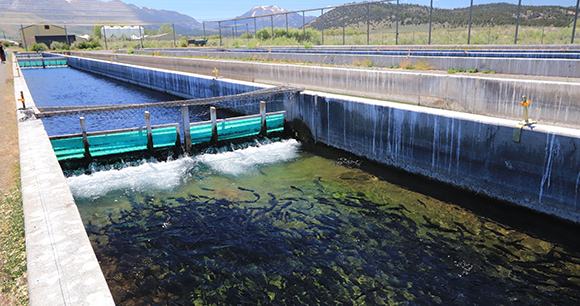
Negative Consequences of Fish Farming
It is not the case, as aquaculture proponents often claim, that aquaculture is a sustainable way to ease the burden on overfished wild stocks while meeting growing demand for seafood. In many aquaculture systems, especially those involving high-demand carnivorous species such as salmon, trout, and shrimp, large quantities of small wild-caught fish are processed into fishmeal and fish oil to feed farmed fish. A “fish in, fish out” (FIFO) ratio is used to indicate the amount of wild-caught fish required as feed to produce a certain amount of farmed fish.
One study based on FAO data estimated that 490–1,100 billion finfish were processed into feed in 2010 alone. The Aquatic Life Institute estimates that over a trillion aquatic animals (including crustaceans) are used as feed in aquaculture systems annually. The overfishing of these smaller “forage” fish has repercussions throughout the ocean ecosystem. The high FIFO ratios of popular farmed species and concomitant depletion of wild species undermine the argument for the sustainability of aquaculture.
Larger net-pen facilities require larger amounts of feed, which can lead to eutrophication (excessive accumulation of nutrients) in surrounding waters, leading to harmful algal blooms and oxygen depletion. Pesticides and other chemicals used in aquaculture can also pollute the surrounding waters, and heavy use of antibiotics to treat and prevent disease in the crowded pens spurs development of antibiotic-resistant bacteria, posing risks to aquatic ecosystems and public health.

Escapes of farmed fish, particularly salmon, from ocean net pens introduce non-native and often genetically modified species into the wild that disrupt native ecosystems and compete with wild populations for resources. Escaped or deliberately introduced farmed fish can also interbreed with wild populations, leading to introduction of harmful traits, genetic dilution, and reduced genetic diversity. Disease outbreaks in aquaculture facilities also pose threats to wild fish populations.
Habitat destruction associated with the expansion of aquaculture facilities, such as the conversion of mangroves or wetlands for shrimp farming, has detrimental effects on coastal ecosystems and the species that depend on them. Lastly, most aquaculture facilities defend against predation by wild species such as marine mammals, sea birds, racoons, bears, and other fish. When physical barriers such as netting or other nonlethal deterrents such as noise or light don’t work, facilities often turn to lethal deterrents such as firearms, water cannons, and explosives.
Decapod Crustaceans
The increasing scientific recognition of sentience in decapod crustaceans, lobsters, shrimp, and crabs has led to increasing concern over their welfare in connection with human uses. Research reveals that these animals possess complex nervous systems and exhibit behaviors indicative of pain perception and cognitive awareness.
Decapods have been shown to not only respond to noxious stimuli, but also to learn new things and interact socially, all of which imply a level of consciousness and subjective experience. Despite mounting evidence of their sentience, however, legal and ethical considerations surrounding the treatment of decapod crustaceans vary widely across jurisdictions, with many countries lacking specific regulations or protections for these animals. Nonetheless, there is a growing movement advocating greater recognition of decapod sentience and implementation of welfare standards to mitigate the suffering these animals experience in various industries, including aquaculture and culinary practices.